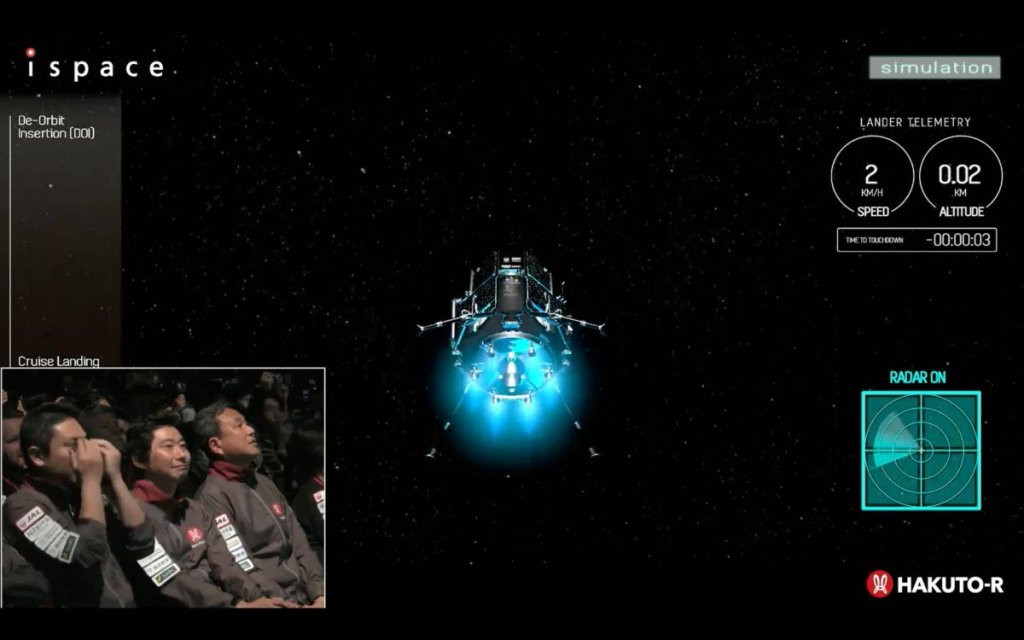Japan’s Hakuto-R lander apparently came up short in its bid to make history today (April 25).
The robotic Hakuto-R, operated by Tokyo-based company ispace, aimed to become the first private spacecraft, and the first Japanese-built vehicle, ever to land softly on the moon.
That doesn’t seem to have happened, however: ispace lost touch with Hakuto-R just as it was scheduled to settle softly onto the gray dirt today at 12:40 p.m. EDT (1640 GMT).
“So, we have to assume that we could not complete the landing on the lunar surface,” ispace founder and CEO Takeshi Hakamada said during a webcast of today’s historic attempt. The company will continue trying to contact the lander and determine what happened, he added.
If today’s try did indeed fail, government-built probes from the United States, the Soviet Union/Russia and China will remain the only robotic explorers to have touched down successfully on Earth’s nearest neighbor.
Lunar timeline: Humanity’s exploration of the moon
A long road to the moon
Today’s landing try capped more than a decade of work by ispace. From 2013 to 2018, the company operated Team Hakuto (“White Rabbit”) in the Google Lunar X Prize, a competition that offered $20 million to the first private outfit to land a robotic probe on the moon.
The Prize expired in 2018 without a winner, but ispace continued developing its lander. It got to the launch pad in December 2022, sending Hakuto-R aloft atop a SpaceX Falcon 9 rocket on a test mission the company called M1.
Hakuto-R took a long and looping path to the moon on M1, arriving in lunar orbit on March 20. The lander made the move down to the surface today, descending from an altitude of 62 miles (100 kilometers) via a series of maneuvers that took about an hour.
The landing site was the floor of the 54-mile-wide (87 km) Atlas Crater, which lies in the Mare Frigoris (“Sea of Cold”) region of the moon’s near side. Hakuto-R seemed to get itself into position well, according to telemetry provided during the webcast, but it couldn’t stick the landing. The planned touchdown time came and went without any word from the lander, leading the mission team to deem the try a likely failure.
Still, Hakuto-R continued beaming data home during the landing attempt, Hakamada said, describing that as one of many milestones notched on M1.
“We are very proud,” he said during the webcast. “We have already achieved many things during this Mission 1.”
M1 was designed primarily to prove out the company’s moon-landing hardware and knowhow, but Hakuto-R nonetheless carried a variety of viable payloads on the mission.
An experimental solid-state battery built by Japanese company Niterra was supposed to get a test in extreme conditions aboard the lander, for example. And Hakuto-R was set to deploy two robots onto the lunar surface: Sora-Q, a transformable robot developed by the Japan Aerospace Exploration Agency and the company Tomy, and Rashid, a 22-pound (10 kilograms) rover that would have been operated by the United Arab Emirates’ space agency.
Rashid aimed to make variety of observations over the course of one lunar day (about 14 Earth days). The little robot carried a variety of cameras, as well as an instrument designed to help characterize the moon’s electrically charged surface environment.
Rashid’s work was to have been augmented by a machine-learning program developed by the Canadian company Mission Control Space Services. This part of the M1 mission was historic, too: No “deep learning” AI system had ever traveled beyond Earth orbit before.
We’ve received another incredible photo from the camera onboard our Mission 1 lander!Seen here is the lunar Earthrise during solar eclipse, captured by the lander-mounted camera at an altitude of about 100 km from the lunar surface. (1/2) pic.twitter.com/pNSI4lPnuxApril 24, 2023
A wave of private moon exploration
Today’s apparent failure will be just a bump in the road for ispace, if all goes according to plan. The company aims to launch its second and third moon-landing missions in 2024 and 2025, respectively.
ispace will continue ramping up its Earth-moon transportation services from there, shooting for two lunar surface missions per year in the near future to help develop a deep-space economy.
“Our vision is to establish an economically viable, sustainable ecosystem in cislunar [space],” Hakamada told Space.com shortly before M1 lifted off.
The 2025 mission, known as M3, is part of NASA’s Commercial Lunar Payload Services (CLPS) program. CLPS employs privately built landers to get agency science equipment down on the lunar surface, with the broader aim of supporting NASA’s Artemis program of crewed lunar exploration.
A number of other CLPS missions are scheduled to lift off in the coming months and years as well. For instance, two private American landers will fly this summer, if all goes according to plan — Astrobotic’s Peregrine (on the debut launch of United Launch Alliance’s Vulcan Centaur rocket) and Intuitive Machines‘ Nova-C (on a Falcon 9).
So Hakuto-R’s landing try was not a singular event. Rather, it was one of the first steps in an envisioned wave of private exploration that could help humanity develop lunar resources such as water ice and get a firm foothold far from Earth.
Hakuto-R wasn’t the first private spacecraft to reach the moon, by the way. CAPSTONE, a tiny cubesat built and operated for NASA by Colorado company Advanced Space, arrived in lunar orbit last November. CAPSTONE is staying in orbit, however; it’s not a surface mission.
The Japanese lander also isn’t the first private craft to attempt a soft lunar touchdown. Israel’s Beresheet spacecraft tried one in April 2019, but it came up short as well.
Mike Wall is the author of “Out There (opens in new tab)” (Grand Central Publishing, 2018; illustrated by Karl Tate), a book about the search for alien life. Follow him on Twitter @michaeldwall (opens in new tab). Follow us on Twitter @Spacedotcom (opens in new tab) or Facebook (opens in new tab).

